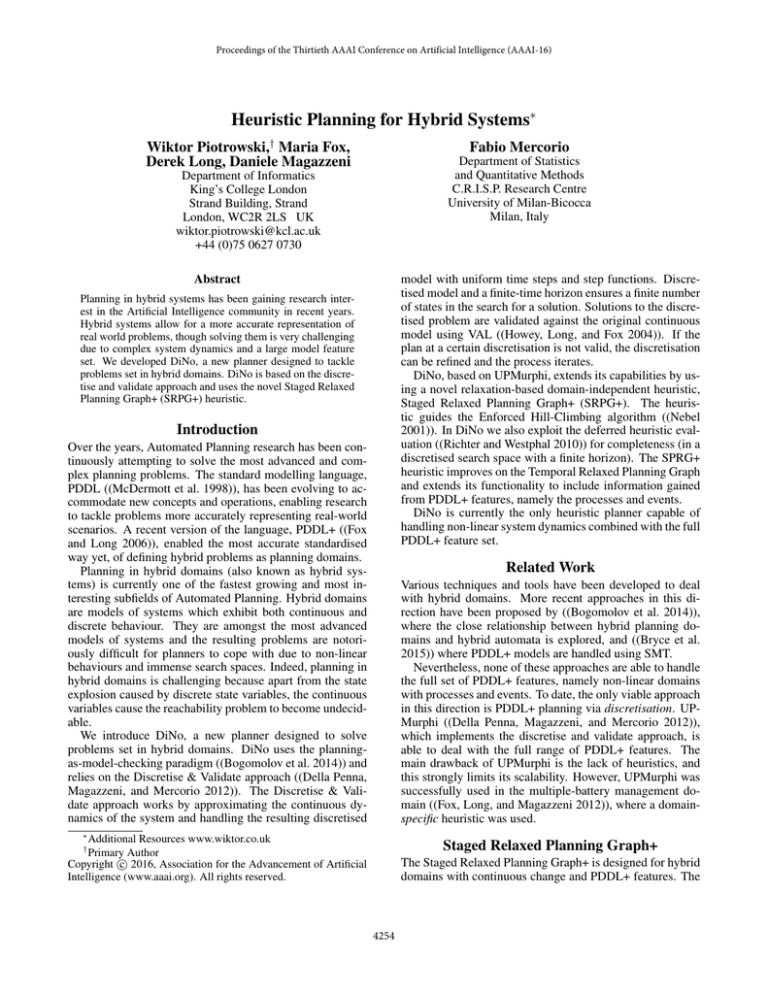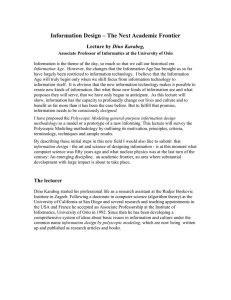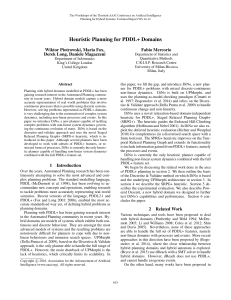
Proceedings of the Thirtieth AAAI Conference on Artificial Intelligence (AAAI-16)
Heuristic Planning for Hybrid Systems∗
Wiktor Piotrowski,† Maria Fox,
Derek Long, Daniele Magazzeni
Fabio Mercorio
Department of Statistics
and Quantitative Methods
C.R.I.S.P. Research Centre
University of Milan-Bicocca
Milan, Italy
Department of Informatics
King’s College London
Strand Building, Strand
London, WC2R 2LS UK
wiktor.piotrowski@kcl.ac.uk
+44 (0)75 0627 0730
model with uniform time steps and step functions. Discretised model and a finite-time horizon ensures a finite number
of states in the search for a solution. Solutions to the discretised problem are validated against the original continuous
model using VAL ((Howey, Long, and Fox 2004)). If the
plan at a certain discretisation is not valid, the discretisation
can be refined and the process iterates.
DiNo, based on UPMurphi, extends its capabilities by using a novel relaxation-based domain-independent heuristic,
Staged Relaxed Planning Graph+ (SRPG+). The heuristic guides the Enforced Hill-Climbing algorithm ((Nebel
2001)). In DiNo we also exploit the deferred heuristic evaluation ((Richter and Westphal 2010)) for completeness (in a
discretised search space with a finite horizon). The SPRG+
heuristic improves on the Temporal Relaxed Planning Graph
and extends its functionality to include information gained
from PDDL+ features, namely the processes and events.
DiNo is currently the only heuristic planner capable of
handling non-linear system dynamics combined with the full
PDDL+ feature set.
Abstract
Planning in hybrid systems has been gaining research interest in the Artificial Intelligence community in recent years.
Hybrid systems allow for a more accurate representation of
real world problems, though solving them is very challenging
due to complex system dynamics and a large model feature
set. We developed DiNo, a new planner designed to tackle
problems set in hybrid domains. DiNo is based on the discretise and validate approach and uses the novel Staged Relaxed
Planning Graph+ (SRPG+) heuristic.
Introduction
Over the years, Automated Planning research has been continuously attempting to solve the most advanced and complex planning problems. The standard modelling language,
PDDL ((McDermott et al. 1998)), has been evolving to accommodate new concepts and operations, enabling research
to tackle problems more accurately representing real-world
scenarios. A recent version of the language, PDDL+ ((Fox
and Long 2006)), enabled the most accurate standardised
way yet, of defining hybrid problems as planning domains.
Planning in hybrid domains (also known as hybrid systems) is currently one of the fastest growing and most interesting subfields of Automated Planning. Hybrid domains
are models of systems which exhibit both continuous and
discrete behaviour. They are amongst the most advanced
models of systems and the resulting problems are notoriously difficult for planners to cope with due to non-linear
behaviours and immense search spaces. Indeed, planning in
hybrid domains is challenging because apart from the state
explosion caused by discrete state variables, the continuous
variables cause the reachability problem to become undecidable.
We introduce DiNo, a new planner designed to solve
problems set in hybrid domains. DiNo uses the planningas-model-checking paradigm ((Bogomolov et al. 2014)) and
relies on the Discretise & Validate approach ((Della Penna,
Magazzeni, and Mercorio 2012)). The Discretise & Validate approach works by approximating the continuous dynamics of the system and handling the resulting discretised
Related Work
Various techniques and tools have been developed to deal
with hybrid domains. More recent approaches in this direction have been proposed by ((Bogomolov et al. 2014)),
where the close relationship between hybrid planning domains and hybrid automata is explored, and ((Bryce et al.
2015)) where PDDL+ models are handled using SMT.
Nevertheless, none of these approaches are able to handle
the full set of PDDL+ features, namely non-linear domains
with processes and events. To date, the only viable approach
in this direction is PDDL+ planning via discretisation. UPMurphi ((Della Penna, Magazzeni, and Mercorio 2012)),
which implements the discretise and validate approach, is
able to deal with the full range of PDDL+ features. The
main drawback of UPMurphi is the lack of heuristics, and
this strongly limits its scalability. However, UPMurphi was
successfully used in the multiple-battery management domain ((Fox, Long, and Magazzeni 2012)), where a domainspecific heuristic was used.
∗
Additional Resources www.wiktor.co.uk
Primary Author
c 2016, Association for the Advancement of Artificial
Copyright Intelligence (www.aaai.org). All rights reserved.
Staged Relaxed Planning Graph+
†
The Staged Relaxed Planning Graph+ is designed for hybrid
domains with continuous change and PDDL+ features. The
4254
DOMAIN
LINEAR GENERATOR
NON-LINEAR GENERATOR
LINEAR SOLAR ROVER
NON-LINEAR SOLAR ROVER
POWERED DESCENT
PLANNER
DiNo
UPMurphi
DiNo
UPMurphi
DiNo
UPMurphi
DiNo
UPMurphi
DiNo
UPMurphi
1
0.34
140.50
3.62
X
0.70
203.26
1.10
288.94
0.68
0.18
2
0.40
X
0.78
X
0.92
X
2.58
X
1.04
0.74
3
0.50
X
2.86
X
1.26
X
4.74
X
1.88
2.98
4
0.60
X
59.62
X
1.52
X
7.10
X
3.52
7.18
5
0.74
X
1051.84
X
1.80
X
9.58
X
2.88
30.08
6
0.88
X
X
X
2.04
X
12.86
X
3.14
126.08
7
1.00
X
X
X
2.28
X
16.48
X
5.26
322.16
8
1.16
X
X
X
2.64
X
21.38
X
3.82
879.52
9
1.38
X
X
X
2.98
X
26.74
X
1.58
974.60
10
2.00
X
X
X
3.30
X
29.90
X
2.26
X
11
1.84
X
N/A
N/A
3.50
X
35.96
X
11.24
X
12
2.06
X
N/A
N/A
3.74
X
42.54
X
42.24
X
13
2.32
X
N/A
N/A
4.00
X
48.06
X
14.90
X
14
2.46
X
N/A
N/A
4.38
X
55.46
X
61.94
X
15
2.88
X
N/A
N/A
5.20
X
62.84
X
19.86
X
16
2.94
X
N/A
N/A
5.40
X
74.50
X
80.28
X
17
3.42
X
N/A
N/A
5.08
X
86.96
X
2.94
X
18
3.54
X
N/A
N/A
5.64
X
95.66
X
2234.88
X
19
3.76
X
N/A
N/A
6.12
X
102.86
X
X
X
20
4.26
X
N/A
N/A
6.02
X
117.48
X
X
X
Table 1: Results for DiNo and UPMurphi (time in seconds) for each problem in our test domains (”X” - planner ran out of
memory, ”N/A” - problem not tested)
Conclusion
SRPG+ is closely based on the successful and well-known
Temporal Relaxed Planning Graph (TRPG) ((Coles et al.
2012)). In the TRPG, the original problem is relaxed and
does not account for the delete effects of actions on propositional facts. Numeric variables are represented as upper and
lower bounds which are the theoretical highest and lowest
values each variable can take at the given fact layer. Each
layer is time-stamped to keep track of the time at which it
occurs.
The Staged Relaxed Planning Graph+ follows the TRPG
relaxation but significantly differs in handling time as well
as processes and events. There are 3 key elements to the
SRPG+ heuristic which make it unique:
Time Staging The Staged Relaxed Planning Graph is
built with all successive fact layers separated by the discretised time step, Δt. This differs from the Temporal RPG
where fact layers exist only at the earliest time of occurrence
of happenings.
Time Passing DiNo depends on an additional action to
advance time (tp) in the search. tp is crucial to discretised
search as it is used to handle continuous change (i.e. actions’
continuous effects, processes and events are applied through
tp). We decided to exploit this approach to extract useful
information and increase the performance of the planner.
The time-passing action can be helpful (prioritised), if its
effects help in achieving the goal. However, we found that
designating tp as helpful in the absence of any other helpful
actions at a given state, can yield improved performance of
our heuristic and propagate the search forward more quickly.
Processes and Events The Staged Relaxed Planning
Graph+ is the first heuristic which explicitly reasons with
processes and events. This results in the evolution of the
system in the SRPG more closely resembling the concrete
system, and thus the SRPG+ yields a more accurate heuristic estimate.
We have presented DiNo, the first heuristic planner capable of reasoning with the full PDDL+ feature set and complex non-linear systems. DiNo is based on the Discretise
& Validate approach, and uses the novel SRPG+ domainindependent heuristic introduced in this paper. We have empirically proved DiNo’s superiority over its competitors for
problems set in hybrid domains. Enriching discretisationbased planning with an efficient heuristic, that takes processes and events into account, is an important step in
PDDL+ planning. Future research will expand DiNo’s capabilities to deal with larger problem instances and infer more
information from processes and events.
References
Bogomolov, S.; Magazzeni, D.; Podelski, A.; and Wehrle, M.
2014. Planning as Model Checking in Hybrid Domains. In Proceedings of the Twenty Eighth Conference on Artificial Intelligence
(AAAI-14). AAAI Press.
Bryce, D.; Gao, S.; Musliner, D. J.; and Goldman, R. P. 2015.
SMT-Based Nonlinear PDDL+ Planning. In Proceedings of the
Twenty-Ninth AAAI Conference on Artificial Intelligence, January
25-30, 2015, Austin, Texas, USA., 3247–3253.
Coles, A. J.; Coles, A.; Fox, M.; and Long, D. 2012. COLIN:
Planning with Continuous Linear Numeric Change. Journal of Artificial Intelligence Research (JAIR) 44:1–96.
Della Penna, G.; Magazzeni, D.; and Mercorio, F. 2012. A Universal Planning System for Hybrid Domains. Appl. Intell. 36(4):932–
959.
Fox, M., and Long, D. 2006. Modelling Mixed DiscreteContinuous Domains for Planning. Journal of Artificial Intelligence Research 27:235–297.
Fox, M.; Long, D.; and Magazzeni, D. 2012. Plan-based Policies
for Efficient Multiple Battery Load Management. J. Artif. Intell.
Res. (JAIR) 44:335–382.
Howey, R.; Long, D.; and Fox, M. 2004. VAL: Automatic Plan
Validation, Continuous Effects and Mixed Initiative Planning Using PDDL. In Tools with Artificial Intelligence, 2004. ICTAI 2004.
16th IEEE International Conference on, 294–301. IEEE.
McDermott, D.; Ghallab, M.; Howe, A.; Knoblock, C.; Ram, A.;
Veloso, M.; Weld, D.; and Wilkins, D. 1998. PDDL - The Planning
Domain Definition Language.
Nebel, B. 2001. The FF Planning System: Fast Plan Generation
Through Heuristic Search. Journal of Artificial Intelligence Research 14:253–302.
Richter, S., and Westphal, M. 2010. The LAMA Planner: Guiding
Cost-Based Anytime Planning with Landmarks. Journal of Artificial Intelligence Research 39(1):127–177.
Evaluation
We evaluated the performance of DiNo on PDDL+ benchmark domains. Note that the only planner able to deal with
the same class of problems as DiNo, is UPMurphi. This
comparison is useful for our evaluation as it highlights the
benefits of the Staged Relaxed Planning Graph+. Table 1
summarises the times taken by DiNo and UPMurphi to solve
problems in our test suite. Note that for all domains we used
the same time discretisation Δt = 1.0, except non-linear
generator where it had to be refined to Δt = 0.5 for problems with 3, 4 and 5 tanks.
4255





